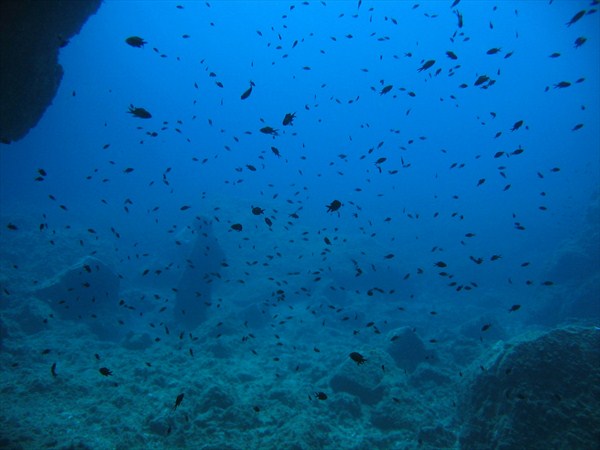La vierge du Lion de Mer EarthCache
-
Difficulty:
-

-
Terrain:
-

Size:  (not chosen)
(not chosen)
Please note Use of geocaching.com services is subject to the terms and conditions
in our disclaimer.
Le lion de mer est un îlot rocheux,situé dans la baie de Saint
Raphael. Le site est un spot de plongée reconnu. On y trouve
notamment une voûte de corail qui est tapissée de coraux en fleur,
et une arche sous marine agrémentée de deux statues : la Vierge et
la Sirène.
The Lion de Mer is a rocky island located in Saint Raphael bay.
This site is a popular diving spot, with a coral cave rich in red
corals, and a natural archway that traverses the island underwater
and is the home to 2 statues, La Vierge (The Virgin Mary) and La
Sirene .
|
 |
Pour répondre aux questions, vous devrez réaliser une plongée
sous marine sur ce spot, la profondeur est supérieure à 10
mètres et inférieure à 15 mètres. Si vous le souhaitez, vous
pourrez en profiter pour prendre en photo et poser en compagnie de
la "vierge".
-La vierge se situe dans le passage rocheux en forme d'arche sous
marine, qui traverse l'ile. Quelles sont les profondeurs des 2
cotés de ce passage ?.
-la vierge est posée sur le sable au pied de la roche volcanique, à
quelle profondeur est elle ?.
-quelle est la hauteur de la statue immergée ?.
You will have to dive on this spot ( depth is in between 10
and 15 meters) to answer to the following questions,
afterwards, as an option, you might take a picture of yourself
together with the statue of "Virgin Mary" which rests
underwater.
-an archway crosses the island, what are the depths of the both
sides of this path ?.
-the statue is located in the sand at the bottom of the lava, what
is the depth of the statue of "Virgin Mary"?
-what is the height of this statue ?
|
Bien entendu, ne plongez jamais seul. Bien que cette plongée
soit accessible aux plongeurs certifiés de tous niveaux (niveau 1
inclus) , et il est préférable de demander conseil aux plongeurs
habitués de ce spot, voir de profiter des nombreuses palanqués
organisées sur ce site par les différents clubs des alentours. Si
vous n’êtes pas plongeur certifié, n’essayez pas
d’atteindre ce spot.
This diving site is a very easy one, it is a training site for
open water certification, but do not try to dive there if you are
not certified diver. Additionaly, do not dive alone please ,and if
you are not used to this site, it is anyway safer to dive with a
diving center. Lots of local diving centers organise very
frequently a dive there.
Géologie:
Le lion de Mer et le lion de Terre sont 2 ilots rocheux couplés par
leur origine gélologique.
A la fin du primaire, un volcanisme important se développe dans la
région. Un volcanisme acide donne des coulées de rhyolite amarante.
Cette roche résiste à l'érosion et perdure jusqu'à aujourd'hui (ce
phénomène est visible au niveau de l'Ile d'Or du Dramont). Un
volcanisme intermédiaire, sous la forme d’une coulée de
trachyte, roche voisine de la rhyolite, a formé les ilôts du Lion
de Terre et du Lion de Mer. Le volcan de la Batterie des Lions est
la bouche de sortie de cette coulée .Ce volcan est maintenant situé
en pleine ville, son affleurement est visible au début du sentier
des douaniers, face aux ilôts des Lions.
Sur les Lions, on peut observer un trachyte à quartz dont la
présentation est en prisme subhorizontale. Dans certaines
conditions de refroidissement, la lave forme des sortes de prismes
perpendiculaires au sens de la coulée. Lorsque les prismes sont
horizontaux la lave montait verticalement :c’est la cheminée
du volcan. Lorsque les prismes sont verticaux : la lave
s’écoulait à la surface.
Geology :
The two islands Lion de Mer and Lion de Terre were formed from the
lava flow of a very early time (Palaeozoic era). Two types of lava
flow can be seen around Saint Raphael : the acid one that forms a
very enduring granite-like rock with small crystals - Rhyolite
(refer to l'Ile d'or). An intermediate type of lava formed the Lion
islands, composed of trachyte. The volcano which issued this lava
is named "La batterie des Lions". It is located now in Saint
Raphael city itself, you can notice it at the beginning of the
coastal path (so-called sentier littoral or "sentier des
Douaniers"), just in front of the 2 Lions islands.
On Lion islands we notice some sub horizontal trachyte
prisms.
Bon geocaching !
Additional Hints
(No hints available.)